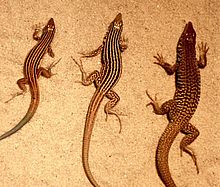- New Mexico whiptail
-
New Mexico whiptail 
Three species of whiptail: little striped whiptail, (C. inornatus), New Mexico whiptail (C. neomexicanus) and tiger whiptail (C. tigris). Conservation status Scientific classification Kingdom: Animalia Phylum: Chordata Class: Reptilia Order: Squamata Suborder: Sauria Family: Teiidae Genus: Cnemidophorus Species: C. neomexicanus Binomial name Cnemidophorus neomexicanus
Lowe & Zweifel, 1952Synonyms Cnemidophorus perplexus
Baird & Girard, 1852
Aspidoscelis neomexicana
Reeder, 2002The New Mexico whiptail (Cnemidophorus neomexicanus) is a species of lizard found in the southern United States in New Mexico and Arizona, and in northern Mexico in Chihuahua. It is the official state reptile of New Mexico.[1] It is one of many lizard species known to be parthenogenic.
Description
The New Mexico whiptail grows from 16.5 to 23 cm in length, and is typically overall brown or black in color with seven pale yellow stripes from head to tail. Light colored spots often occur between the stripes. They have a white or pale blue underside, with a blue or blue-green colored throat. They are slender bodied, with a long tail.
Behavior
Like most other whiptail lizards, the New Mexico whiptail is diurnal and insectivorous. They are wary, energetic, and fast moving, darting for cover if approached. They are found in a wide variety of semi-arid habitats, including grassland, rocky areas, shrubland, or mountainside woodlands. Reproduction occurs through parthenogenesis, with up to four unfertilized eggs being laid in mid summer, and hatching approximately eight weeks later.
The New Mexico whiptail lizard is a crossbreed of a western whiptail which lives in the desert and the little striped whiptail that favours grasslands. The lizard is a female-only species that reproduces by producing an egg through parthenogenesis. Because the genetic information has already been recombined in meiosis, the offspring is not a perfect clone. Despite being an all female species, the whiptail still engages in "mock mating" with other members of its own species, giving rise to the common nickname "lesbian lizards". A common theory is that this behavior stimulates ovulation, as those who do not "mate" do not lay eggs.
References
- ^ "Chapter VIII. New Mexico state animals". New Mexico Envirothon. http://www.nmenvirothon.com/Wildlife/Chapter%20%20VIII-New%20Mexico%20State%20Animals.pdf. Retrieved January 22, 2011.
Categories:- IUCN Red List least concern species
- Teiidae
- Symbols of New Mexico
Wikimedia Foundation. 2010.

